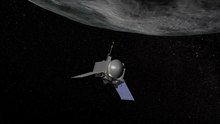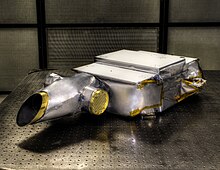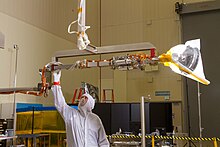OSIRIS-REx
| OSIRIS-REx | |||||||||||||||||||||||||||||||
|---|---|---|---|---|---|---|---|---|---|---|---|---|---|---|---|---|---|---|---|---|---|---|---|---|---|---|---|---|---|---|---|
 OSIRIS-REx approaching (101955) Bennu (artist's impression) |
|||||||||||||||||||||||||||||||
| NSSDC ID | 2016-055A | ||||||||||||||||||||||||||||||
| Mission goal | Asteroid (101955) Bennu | ||||||||||||||||||||||||||||||
| operator |
|
||||||||||||||||||||||||||||||
| Manufacturer | Lockheed Martin | ||||||||||||||||||||||||||||||
| Launcher | Atlas V (411) | ||||||||||||||||||||||||||||||
| construction | |||||||||||||||||||||||||||||||
| Takeoff mass | 2110 kg (of which 1230 kg fuel) | ||||||||||||||||||||||||||||||
| Course of the mission | |||||||||||||||||||||||||||||||
| Start date | September 8, 2016 | ||||||||||||||||||||||||||||||
| launch pad | Cape Canaveral , LC-41 | ||||||||||||||||||||||||||||||
| End date | September 24, 2023 (planned) | ||||||||||||||||||||||||||||||
|
|||||||||||||||||||||||||||||||
OSIRIS-REx (Origins Spectral Interpretation Resource Identification Security - Regolith Explorer) is a spacecraft of NASA , on 8 September 2016, an Atlas V rocket , was launched by the asteroid (101955) Bennu sample return to Earth . Bennu is a near-Earth asteroid of the - most common - C-type , which is carbon-rich and therefore has a dark surface. Bennu has a diameter of 494 m.
After New Horizons and Juno , OSIRIS-REx is the third space probe in the New Frontiers program . The decision for the mission was announced on May 25, 2011 after it had prevailed in a selection process against a Venus lander that is supposed to investigate the atmosphere and a soil sample (Venus In-Situ Explorer), and against a probe that Bring material samples from the South Pole Aitken Basin of the moon to earth (MoonRise). The probe was built by the US technology group Lockheed Martin and completed in October 2015 and then extensively tested.
Mission history
OSIRIS-REx was launched on September 8, 2016. One year after take-off, on September 22, 2017, it flew by again 17,000 km away for a swing-by , and on December 3, 2018, it reached the asteroid Bennu .
On December 31, 2018, the probe entered orbit, in which it is supposed to map the surface of the asteroid core in high resolution at a distance of about 1.75 km from the asteroid core and measure the Jarkowski effect (the influence of the varying degrees of warming of the asteroid surface on the course of the asteroid's orbit Asteroids). The probe takes around 62 hours to complete one orbit. Bennu is the smallest object in space that has ever been orbited by a probe, and no celestial body has ever been orbited so close. The Rosetta probe had the shortest distance to date in May 2016 when it orbited comet 67P / Churyumov-Gerasimenko at a distance of 7 km.
During the approximately 500-day observation phase, the orbit was gradually lowered to 700 m. Every square centimeter of the asteroid was scanned, also to find a suitable place for material sampling. To do this, OSIRIS-REx came within a few meters of the asteroid on October 20, 2020, unfolded a kind of robotic arm called TAGSAM (Touch-And-Go Sample Acquisition Mechanism), touched the surface of the asteroid for about five seconds and hit it under pressure exposed nitrogen to stir up and capture sample material. When the sample was taken, the sampling head penetrated approx. 50 cm into the surface of the asteroid.
The plan was to collect at least 60 g of regolith rock and an additional 26 cm³ of fine-grain surface dust. The amount actually collected should be estimated with the help of camera images and inertia tests with the loaded probe. If the amount had turned out to be too small, a second attempt at a different location on the celestial body selected in advance would have been possible.
However, the camera images were sufficient to ensure that more than the desired minimum amount of 60 g had been collected and that a second such maneuver was no longer necessary. After the extraction, the probe was initially allowed to slowly drift away to a distance of around 2200 km from Bennu, and then slowly reduced the distance again from mid-January 2021. On March 6, 2021, a second approach maneuver is to be carried out at a distance of about 250 km, which should lead the probe again to about 3.8 km past the sampling point. [obsolete] Among other things, high-resolution images of the extraction point named Nightingale are to be recorded in order to be able to examine the effects of extraction on the surface.
On May 10, 2021, the return trip to Earth was initiated by igniting the main engines. In September 2023, the return capsule , which is similar to the Stardust probe, will be deployed near the earth and will land on the Utah Test and Training Range on September 24, 2023 . After the return capsule has been set down, the probe will make another course change and swing into a solar orbit.

f engines, g star sensors , h antenna, j antenna, k helium tank;
1 Lidar , 2 OLA, 3 OCAMS, 4 OTES, 5 OVIRS
construction
OSIRIS-REx is cuboid, 3.10 m wide and 2.72 m high and had a mass of 2,100 kg when it was launched. The probe itself accounted for 880 kg. On both sides of the probe there are almost square brackets with solar cells with a total area of 8.5 m². Including the laid out solar cantilever, the result is a length of 6.20 m, a width of 2.43 m and a height of 3.15 m. The central structure is a cube with an edge length of 2.3 m and a weight of 160 kg. Depending on the distance to the sun, the solar modules, which can be swiveled in the X and Y axes, generate between 1,226 and 3,000 watts. For communication with the earth in the X band, the probe was a high gain - parabolic antenna m with a diameter of about 2.1, a mid-gain antenna and equipped two low gain antennas. The maximum data rate of the parabolic antenna is 914 kbit / s.
The probe is equipped with the following instruments:
- OCAMS (OSIRIS-REx Camera Suite), consisting of three cameras (Polycam, Mapcam, SAMCAM)
- OVIRS (OSIRIS-REx Visible and IR Spectrometer), a spectrometer for infrared and the range of visible light, 17.8 kg
- OTES (OSIRIS-REx Thermal Emission Spectrometer), a spectrometer for thermal radiation, 6.3 kg
- OLA (OSIRIS-REx Laser Altimeter), a laser altimeter , 21.4 kg
- REXIS (Regolith X-ray Imaging Spectrometer), an X-ray spectrometer
- TAGSAM (Touch-And-Go Sample Acquisition Mechanism), the collection mechanism for the material samples from Bennu's surface
See also
- List of space probes
- Lucy - planned NASA mission to research several Jupiter Trojans
- Rosetta - ESA mission to comet 67P / Churyumov – Gerasimenko
- Destiny + - JAXA mission to the asteroid (3200) Phaethon
- Dawn (space probe) - NASA mission to the asteroid (4) Vesta and the dwarf planet (1) Ceres
Web links
- AsteroidMission.org. Mission website.
- How and Why Is NASA's OSIRIS-REx Mission Visiting Asteroid Bennu? YouTube video, 6:39 min.
- NASA's OSIRIS-REx: Mission to Bennu. YouTube video, 7:49 min.
- D. Overbye, J. Corum, J. Drakeford: Osiris-Rex: Chasing Asteroid Bennu. New York Times / Science. Animation, 3:31 min.Retrieved October 23, 2020.
Individual evidence
- ↑ Interview with Dante Lauretta (English) on YouTube, accessed on October 23, 2020.
- ↑ Justin Ray: OSIRIS-REx probe launched to asteroid in compelling search for the origins of life. In: SpaceflightNow.com. September 9, 2016, accessed October 23, 2020 .
- ↑ a b OSIRIS-REx. Asteroid Sample Return Mission. (PDF; 2 MB) In: NASA.gov. August 2016, accessed on 23 October 2020 (Press Kit).
- ^ Robert Garner: NASA to Launch New Science Mission to Asteroid in 2016. In: NASA.gov. October 5, 2011, accessed October 23, 2020 .
- ↑ a b Chris Gebhardt: OSIRIS-REx enters environmental testing ahead of launch next year. In: NasaSpaceflight.com. October 22, 2015, accessed October 23, 2020 .
- ↑ Kenneth Chang: NASA's Osiris-Rex Arrives at Asteroid Bennu After a Two-Year Journey. In: NYTimes.com. December 3, 2018, accessed October 23, 2020 .
- ↑ a b Lonnie Shekhtman: NASA's OSIRIS-REx Spacecraft Enters Close Orbit Around Bennu, Breaking Record. In: Solarsystem.Nasa.gov. December 31, 2018, accessed October 23, 2020 .
- ↑ "Osiris Rex" probe sets orbit record at asteroid. In: Welt.de. January 1, 2019, accessed October 23, 2020 .
- ^ "Osiris Rex" mission. NASA probe successfully sucks up asteroid dust. In: Spiegel.de. October 21, 2020, accessed October 23, 2020 .
- ↑ a b OSIRIS-REx to Fly a Farewell Tour of Bennu. In: NASA.gov. Retrieved February 17, 2021 .
- ↑ Dante S. Lauretta: OSIRIS-REx Asteroid Sample-Return Mission. In: Joseph N. Pelton et al .: Handbook of cosmic hazards and planetary defense. Springer, Cham 2015, ISBN 978-3-319-03951-0 , p. 544.
- ↑ OSIRIS-REx. In: NASA.gov. Retrieved October 23, 2020 .
- ↑ NASA's OSIRIS-REx Spacecraft Successfully Touches Asteroid. In: NASA.gov. Sean Potter, October 21, 2020, accessed October 25, 2020 .
- ↑ a b Mission Status - OSIRIS-REx. In: NASA.gov. Retrieved February 17, 2021 .
- ↑ Mission timeline. In: AsteroidMission.org. Retrieved October 23, 2020 .
- ↑ "Osiris Rex" probe started successfully. In: ORF.at. September 9, 2016, accessed October 23, 2020 .
- ↑ a b OSIRIS-REx. In: Bernd-Leitenberger.de. March 27, 2017, accessed October 23, 2020 .
- ↑ a b c NASA’s OSIRIS-REx asteroid sample return mission. (PDF; 136 kB) In: NASA.gov. Accessed on October 23, 2020 (information sheet).
- ↑ OSIRIS-REx. In: Directory.eoPortal.org. Retrieved October 23, 2020 (American English).
- ^ OSIRIS-REx Spacecraft. In: Spaceflight101.com. Retrieved October 23, 2020 .
- ^ Karl Hille: OSIRIS-REx Spacecraft and Instruments. In: NASA.gov. August 4, 2017, accessed October 23, 2020 .
- ↑ Karl Hille: OCAMS instrument suite. In: NASA.gov. July 28, 2016, accessed October 23, 2020 .
- ↑ OCAMS POLYCAM. In: AsteroidMission.org. Retrieved October 23, 2020 .
- ↑ OCAMS MAPCAM. In: AsteroidMission.org. Retrieved October 23, 2020 .
- ↑ OCAMS SAMCAM. In: AsteroidMission.org. Retrieved October 23, 2020 .
- ↑ OCAMS SAMCAM. In: Spaceflight101.com. Retrieved October 23, 2020 .
- ↑ Karl Hille: OVIRS Will Observe Bennu in Visible and Near-Infrared Light. In: NASA.gov. July 8, 2015, accessed October 23, 2020 .
- ↑ Karl Hille: OTES Will Map Mineral and Chemical abundances. In: NASA.gov. June 26, 2015, accessed October 23, 2020 .
- ^ Karl Hille: Laser Altimeter Will Create 3-D Maps of Bennu. In: NASA.gov. December 17, 2015, accessed October 23, 2020 .
- ↑ Karl Hille: REXIS Will Image Bennu in X-Rays. In: NASA.gov. January 7, 2016, accessed October 23, 2020 .
- ↑ Karl Hille: TAGSAM Sample Return Arm. In: NASA.gov. July 28, 2016, accessed October 23, 2020 .




